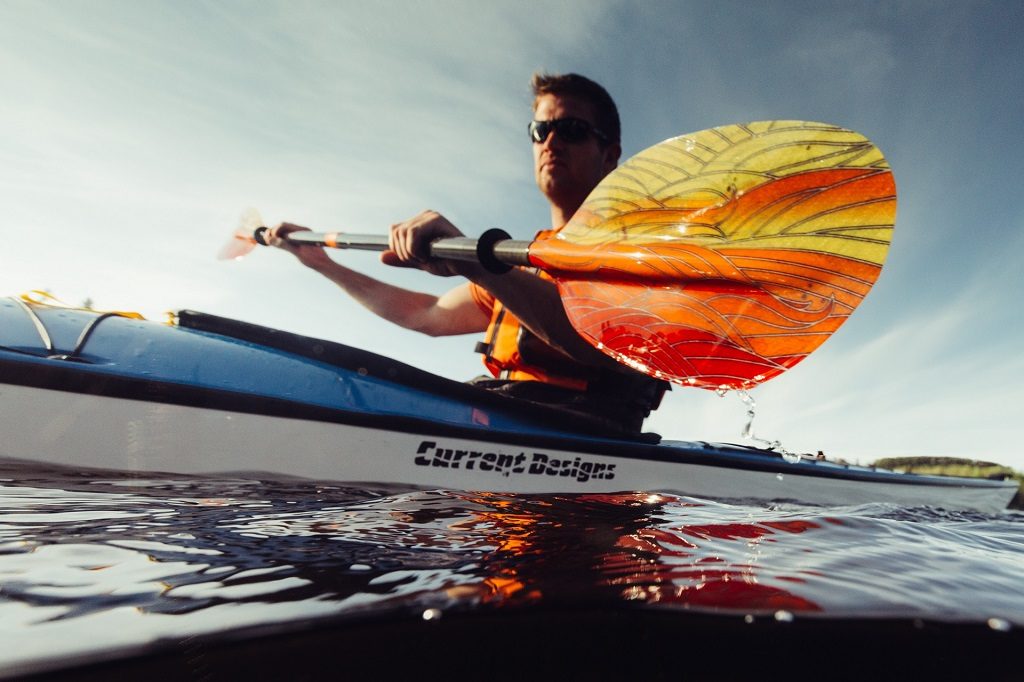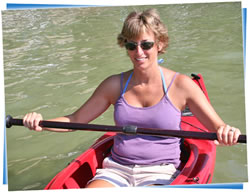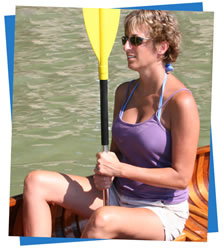Kayak Paddles
The length and type of your kayak paddle depends on a number of factors: your height, the shape of your kayak, your seat height, your paddling technique (vertical or horizontal), and your stroke tempo just to name a few! So, you can see, there’s a little more to it than just grabbing a paddle and heading down the river.
Different paddle lengths are like gears on a bicycle. Some people like to spin while others like to coast. As you read through the information below, keep in mind that your personal preferences will play a large role in selecting the right paddle. If you’re not sure what your preferences are at this point, we have the experience to ask the right questions and lead you in the right direction.
The paddle you choose is at least as important as the kayak itself, and both need to fit you like a glove for the best paddling experience!
Sizing your paddle
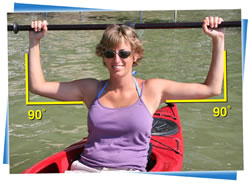
To size your paddle, first place your hands on the shaft approximately as you would position them for a bench press.
Keeping your hands in this position, raise the paddle directly over and rest it on your head. Look in a mirror or have a friend check that your elbows are square. With your hands positioned correctly, there should be 6 – 12″ between your hands and the paddle blade.
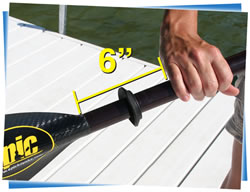
For narrower, shallow boats such as those used for touring, flatwater, sprint racing, whitewater or wave surfing the paddles are typically quite short, from 190-220cm (82 – 88″). For these boats, there is usually a 6″ space between your hand and the paddle blade.
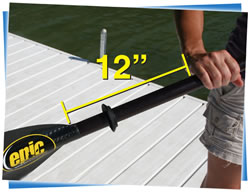
For wider or higher boats such a sea kayaks or wide, stable beginner kayaks, paddles need to be longer. It’s no fun to hit your knuckles on the side of the boat because your paddle is too short, believe us! Normally, paddles for these boats are 220-240cm (88-95″), with a 12″ space between your hand and the blade.
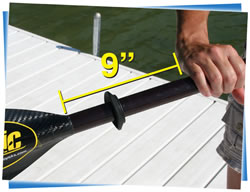
Compromising between the two lengths is a good idea, especially if you paddle different boats or if you change your paddling style frequently. This would put the dimension between your hand and the blade at about 9.”
Left or Right Hand Control?
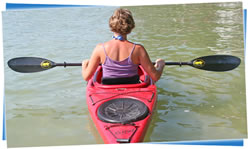 Once your paddle is sized, the next step is to determine which hand will “control” the paddle, and it may or may not be the hand your write with. Basically, if you paddle right-handed, your right hand will grip the shaft firmly, while your left hand allows the shaft to rotate freely as you paddle, and vice versa.
Once your paddle is sized, the next step is to determine which hand will “control” the paddle, and it may or may not be the hand your write with. Basically, if you paddle right-handed, your right hand will grip the shaft firmly, while your left hand allows the shaft to rotate freely as you paddle, and vice versa.
Beginning paddlers often choose to use a paddle that is not feathered – that is, the paddle blades are in-line with each other, allowing both hands to control the paddle equally. For this situation, it is not necessary to determine if you paddle right- or left-handed – just grip the paddle with both hands and start paddling.
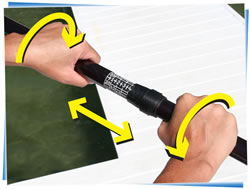
Experienced paddlers realize the benefit of feathering the paddle blades (turning them at an angle to each other). This cuts down on wind resistance and allows for a more efficient stroke. How much the blades are feathered depends on personal reference, and for this reason we recommend an adjustable paddle that allows for an unlimited number of angles, right- and left-hand control, and a range of paddle lengths.
 To adjust a paddle for right-hand control, hold the shaft firmly with your right hand, with the power face of the right blade facing you (an Epic paddle is shown in the photos – different manufacturers use different adjustment methods). Rotate the left-hand shaft away from you to the desired angle, so the power face of the left blade is facing up. Lock the shaft in place and you’re good to go.
To adjust a paddle for right-hand control, hold the shaft firmly with your right hand, with the power face of the right blade facing you (an Epic paddle is shown in the photos – different manufacturers use different adjustment methods). Rotate the left-hand shaft away from you to the desired angle, so the power face of the left blade is facing up. Lock the shaft in place and you’re good to go.
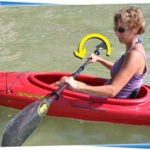 To adjust a paddle for left-hand control, hold the shaft firmly with your left hand, with the power face of the left blade facing you. Rotate the right-hand shaft away from you to the desired angle, so the power face of the right blade is facing up. Lock the shaft in place.
To adjust a paddle for left-hand control, hold the shaft firmly with your left hand, with the power face of the left blade facing you. Rotate the right-hand shaft away from you to the desired angle, so the power face of the right blade is facing up. Lock the shaft in place.
With a little trial and error, you’ll quickly determine which hand you’re most comfortable controlling the paddle with, and which angle of feather works best for you. From this point, there are a number of things to consider – the weight and construction of the paddle and the shape of the blade being two important factors. We can’t cover it all here – the best thing to do is stop in and talk paddles with us. We have a lot on hand for you to see, touch and feel. You can also surf over to Epic’s website and go through their interactive paddle selector – we find this very helpful and accurate!
 Canoe Paddles
Canoe Paddles
There are three “formulas” for fitting a canoe paddle, but keep in mind that there isn’t one sure-fire, here-you-go method. Every formula we’ve run across misses critical information needed to accurately select the best size for you.
For instance, measuring the overall length of the paddle is missing the fact that different paddles have different blade lengths. A 66″ paddle with a 26″ blade will put your top hand 40″ above the water, but a 66″ paddle with a 16″ blade will put your top hand 10″ higher – that’s a big difference!
While they can be helpful as general guidelines, no “formula” can take into account that some people prefer a higher top hand or a quicker stroke rate, while others prefer a more leisurely pace. Changing your paddle length is like changing gears on a bicycle – some people like to spin while others just like to coast. So, take each of the three formulas below with a grain of salt.
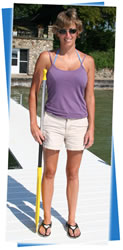
The Traditional Method
Standing straight, rest the blade of the paddle beside your feet. Does the hand grip fit under your armpit? Yep, that’s your size!
Method 2
While sitting on your canoe seat, invert the paddle and place the hand grip on the seat between your legs. The spot where the shaft meets the blade should be at your chin.
Method 3

Hold the paddle as usual, with one hand on the shaft and one on the hand grip. Keeping your hands in that position, raise the paddle directly above your head, and look in a window or a mirror to see if both elbows are at a right angle. Choose a paddle of the proper length to allow this spacing of your hands.
After you have an approximate size, you need to consider the width of your boat and your paddling posture. If you bend at the waist, you’ll want a shorter shaft. If you sit up very straight or plan to kneel, you’ll want to adjust the length accordingly.
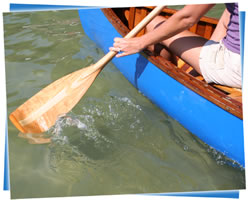 Will you be using a bent- or straight-shaft paddle? Bent shaft paddles offer a more efficient stroke and are usually sized a little shorter based on preference. Yet another consideration is the material the paddle is made out of, with the most important factor being weight. If you’re going to paddle for a long distance, the swing weight will start to add up quickly and your arms will feel it!
Will you be using a bent- or straight-shaft paddle? Bent shaft paddles offer a more efficient stroke and are usually sized a little shorter based on preference. Yet another consideration is the material the paddle is made out of, with the most important factor being weight. If you’re going to paddle for a long distance, the swing weight will start to add up quickly and your arms will feel it!
The bottom line is, choosing the right size paddle is a very personal choice. While you may not know what your preferences are, we know enough to ask the right questions to lead you in the right direction. The right paddle will give you the best paddling experience, and we’ll help you find it!
Stand-Up Paddle Boards (SUP’s) Paddles
The method for choosing a paddle for your Stand-Up Paddle Board is pretty simple. Stand-Up paddles should be your height plus 6”-12” depending on what type of paddling you’ll be doing. For Surfing, you’ll want a paddle that is 6”-8” greater than your height. For Flatwater paddling, choose a paddle that is 8”-10” taller than you. If you’re going to Race, then go with a paddle that is 10”-12” taller than you. Here’s a helpful chart that explains this.
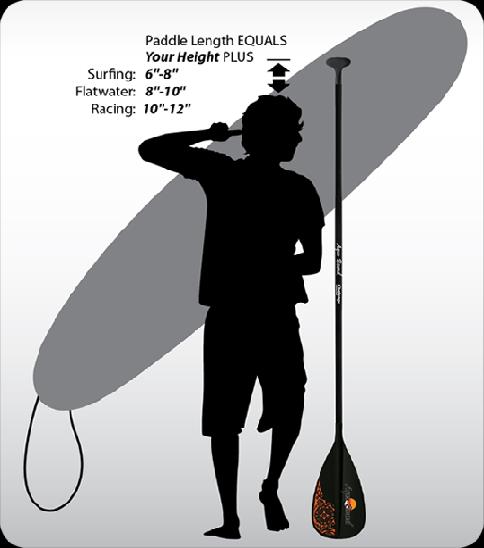
You can also visit our friends over at Aquabound and use their paddle guide to help determine the paddle that is best suited to your needs.
